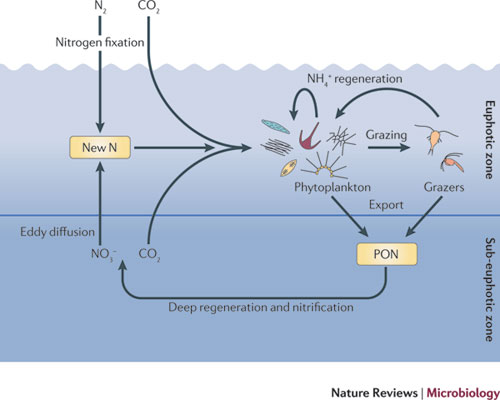 ©2020 Biological and Chemical Oceanography Data Management Office.
©2020 Biological and Chemical Oceanography Data Management Office.Funded by the U.S. National Science Foundation
NSF Award Abstract:
Coastal marine ecosystems are seasonally dynamic and highly productive. Phytoplankton populations shift from nutrient replete conditions in the spring to nutrient poor conditions in other seasons. The San Pedro Ocean Time-series (SPOT), located 17 km offshore between Los Angeles Harbor and Catalina Island, is a representative and accessible model coastal system with regular sampling and a substantial archive of relevant observations. The SPOT program has cataloged the dynamics, diversity, and productivity of microbial populations since 2000. With rising carbon dioxide (CO2) concentrations and resulting decreases in surface pH, it is critically important to understand the nutrient controls on primary production in coastal waters and the capacity of coastal ecosystems to sequester CO2. This project will examine rates of primary production, nitrogen uptake associated with primary production, and the oxidation of ammonium to nitrate (nitrification), at SPOT over two seasonal cycles. It will also contribute to the development of human resources in the marine sciences through the training of undergraduate and graduate students at the University of Southern California and the University of Maryland. The researchers participate in education outreach activities (e.g. through the Centers for Ocean Sciences Education Excellence programs), and will incorporate findings from this study in those presentations.
This project will investigate primary production and nitrogen (N) dynamics at SPOT and specifically implement an analysis of new production. The new production conceptual model has been a powerful organizing principle in biological oceanography and provides a means to constrain the amount of primary production that may be exported or "sequestered" from the system. Despite qualifications to the definitions of new and regenerated forms of N as originally articulated, the concept has, for the most part, been narrowly applied, specifying nitrate as the primary form of new N, and ammonium as the predominant recycled form. Evidence continues to accumulate that these definitions may warrant expansion. N fixation can be at times a substantial source of new N; similarly, forms of dissolved organic N (e.g., urea) may contribute significantly to recycled production, but the specific organisms taking part in these transformations are still uncertain. Nitrification in the upper water column may also compromise the strict definitions of new and recycled N. Scientists can now probe more deeply into new and regenerated production, and directly identify major agents of these processes using new molecular techniques. This project will quantify new and regenerated production in a coastal ecosystem, illuminating the predominant compounds involved. Rates of primary production, nitrate, ammonium and urea assimilation, N2 fixation, and nitrification will be determined in the upper water column in concert with monthly SPOT cruises. In tandem, two stable isotope probing (SIP) approaches (conventional SIP for nitrate, ammonium and urea uptake coupled to high throughput sequencing and microarray based Chip-SIP for N2 fixation) will be used to directly identify the major agents involved in these processes, along with the uptake of 13C-urea into nitrifier biomass. The following two hypotheses will be tested:
1. N2 fixation is a substantial source of new N in coastal waters of Southern California supporting export production.
2. Forms of dissolved organic N, and specifically urea, can be substrates for nitrification and contribute substantially to regenerated production.
See the related project "Direct Identification and Characterization of Marine Heterotrophic Nitrogen Fixers by Stable Isotope Probing", funded by OCE-1341178, that involved novel stable isotope probing (SIP) methods.

Lead Principal Investigator: Douglas G. Capone
University of Southern California (USC-WIES)
Principal Investigator: Alyson E. Santoro
University of California-Santa Barbara (UCSB)
Contact: Matt Tiahlo
University of Southern California (USC-WIES)
NSPOT Data Management Plan (44.99 KB)
01/26/2015